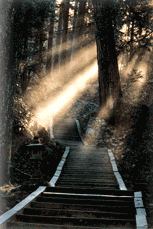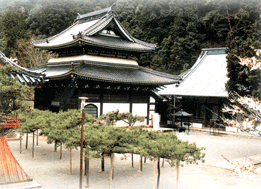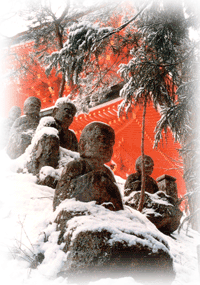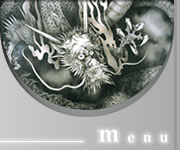Address: 22 Motoyama, Takasaka-cho, Mihara-shi, Hiroshima-ken, 729-0471
Japan
Tel: 0848-66-3502; Fax: 0848-66-2563
http://www.buttsuji.or.jp

Buttsu-ji was established in 1397 by Kobayakawa Haruhira
小早川春平(n.d.), the
regional lord of the Mihara area. The Zen master Guchu Shukyu
愚中周及
(1323–1409; also known as Buttoku Daitsu Zenji
佛徳大通禪師) was invited to become
founding abbot. Guchu had become a monk under Muso Soseki at the age of
thirteen, then, at nineteen, sailed for China and studied under Jixiu Qiliao
即休契了 (J., Shikkii Kairyo; 1269–1351) for a period of ten years. The name Buttsu-ji derives from
that of Shukyu’s Chinese master Qiliao, who Shukyu designated as honorary
founder, and whose title was Buttsu Zenji
佛通禪師.
 Under the patronage
of the Kobayakawa family, Buttsu-ji reached the height of its prosperity.
Emperor Go-Komatsu 後小松 (r. 1392–1412) permitted the abbot to wear a purple
robe, and the Ashikaga shogunate designated it a Kigan Gokokuji 祈願護国寺 (a
temple to pray for the peace of the nation). The temple’s fortunes declined
following the fifteenth-century Onin Wars, however, despite somewhat of a
revival under Kobayakawa Takakage 小早川隆景 (1533–1597). A fire in 1795
destroyed several of the main buildings, which were restored in 1808. In
1905 the temple was named head of the Buttsu-ji branch of Rinzai Zen; it is
the only Rinzai headquarters temple west of Kyoto. Buttsu-ji presently has
forty-seven associated temples.
Under the patronage
of the Kobayakawa family, Buttsu-ji reached the height of its prosperity.
Emperor Go-Komatsu 後小松 (r. 1392–1412) permitted the abbot to wear a purple
robe, and the Ashikaga shogunate designated it a Kigan Gokokuji 祈願護国寺 (a
temple to pray for the peace of the nation). The temple’s fortunes declined
following the fifteenth-century Onin Wars, however, despite somewhat of a
revival under Kobayakawa Takakage 小早川隆景 (1533–1597). A fire in 1795
destroyed several of the main buildings, which were restored in 1808. In
1905 the temple was named head of the Buttsu-ji branch of Rinzai Zen; it is
the only Rinzai headquarters temple west of Kyoto. Buttsu-ji presently has
forty-seven associated temples.
 Buttsu-ji is noted for its mountain scenery, as well as for buildings like the Mountain Gate (Sanmon), built in 1796; the Dharma/Buddha Hall (Butsuden ken Hatto), built in 1809 and with Shakyamuni Buddha as the main image and a Cloud Dragon painting on the ceiling; the Abbot’s Quarters (Daihojo), which serves as Buttsu-ji’s Main Hall (Hondo), with an Eleven-faced Kannon Bodhisattva as the main image; and the Taho-to 多
寳塔, the Many Treasures Pagoda.
Buttsu-ji is noted for its mountain scenery, as well as for buildings like the Mountain Gate (Sanmon), built in 1796; the Dharma/Buddha Hall (Butsuden ken Hatto), built in 1809 and with Shakyamuni Buddha as the main image and a Cloud Dragon painting on the ceiling; the Abbot’s Quarters (Daihojo), which serves as Buttsu-ji’s Main Hall (Hondo), with an Eleven-faced Kannon Bodhisattva as the main image; and the Taho-to 多
寳塔, the Many Treasures Pagoda.



